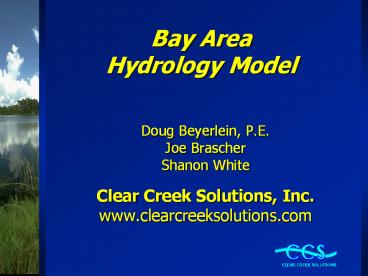Bay Area Hydrology Model PowerPoint PPT Presentation
Title: Bay Area Hydrology Model
1
Bay Area Hydrology Model
- Doug Beyerlein, P.E.
- Joe Brascher
- Shanon White
- Clear Creek Solutions, Inc.
- www.clearcreeksolutions.com
2
Bay Area Hydrology Model
- This introductory presentation was given at BAHM
workshops held in November 2006 at - San Jose, CA
- San Mateo, CA
- Hayward, CA
3
Bay Area Hydrology Model
- Developed for
- Alameda Countywide Clean Water Program
- Santa Clara Valley Urban Runoff Pollution
Prevention Program - San Mateo Countywide Stormwater Pollution
Prevention Program
4
Presentation
- Introduction
- BAHM Background and Theory
- BAHM and HSPF
- BAHM Application
- BAHM Demo
- Questions Answers
5
Introduction
- BAHM software platform was originally developed
for the State of Washington Department of
Ecology. - Project Manager Dr. Foroozan Labib
- Department of Ecology
- PO Box 47600
- Olympia, WA 98504-7600
- (360) 407-6439
- email flab461_at_ecy.wa.gov
6
BAHM Background and Theory
- Flow duration standard based on erosive flows.
7
BAHM Background Flow Duration Analysis Percent
of time the flow exceeds a specific value.
- Requires continuous simulation hydrology to
compute flow duration.
8
BAHM Background
- Single event modeling doesnt work because
- Single-event flow frequency standards are based
on inappropriate assumptions. - Single-event modeling cannot compute flow
durations (percent of time flows exceed a
specific value). For BAHM the flow duration
range of concern is from 10 of the 2-year to
10-year flow event.
9
BAHM Background
- Continuous simulation hydrology models the entire
hydrologic cycle for multiple years. - Stormwater runoff surface runoff interflow.
10
Where the rain goes
100
Evapotranspiration
Surface Runoff
Interflow
Groundwater/Base Flow
0
Land use development
Forest
Impervious
11
BAHM Capabilities
- BAHM uses continuous simulation hydrology to
compute stormwater runoff for both pre-project
and post-development conditions. - Pre-project Post-development
12
BAHM Capabilities
- BAHM continuous simulation computations from
HSPF (included in BAHM software). - HSPF runs in the background with calibrated
parameter values and local meteorological data. - HSPF sponsored and funded by EPA and USGS.
13
How HSPF works
- Drainage areas are divided into pervious land
segments based on soil, vegetation, and land
slope and impervious land segments. - Pervious and impervious segments are linked to
conveyance pathways (pipes, ditches, ponds,
streams, rivers, lakes, etc.) - Historic rainfall and evaporation are used as
input.
14
How HSPF works
- The entire water cycle is modeled on an hourly
or shorter time step for multiple years. - The model computes changes in soil moisture,
evapotranspiration, and runoff every time step. - Three types of runoff
- surface runoff
- interflow
- groundwater/base flow
15
How HSPF works
- Pervious and impervious parameter values are
calibrated using observed streamflow data. - Calibration uses multiple years of observed flow
data so that the model is calibrated for both dry
years and wet years.
16
How BAHM works
- Calibrated parameter values are built into BAHM
(different calibrated parameter values are used
for different counties). - Local precipitation and evaporation data are
included in BAHM.
17
How BAHM works
- HSPF model construction/calibration/parameterizat
ion - Castro Valley Creek, Alameda County
- Alameda Creek, Alameda and Santa Clara counties
- Ross Creek, Santa Clara County
18
How BAHM works
- Meteorological data Santa Clara County
San Jose Morgan Hill
19
How BAHM works
- Meteorological data San Mateo County
San Francisco
20
How BAHM works
- Meteorological data Alameda County
Berkeley Newark Livermore
21
How BAHM works
- User locates project on county map, inputs
pre-project and post-development land use, and
proposed mitigation measure(s). - Pre-project and mitigated flows are compared at
Point of Compliance (POC). - Mitigated flows are not allowed to exceed flow
duration standards.
22
How BAHM works
- User outputs report file and project file.
- Output files can be submitted to the permitting
agency for approval. - Permitting agency can load project file and
rerun analysis, if needed. - Report file summarizes input data and output
results.
23
How BAHM works
- Guidance/help is provided by
- User Manual
- Training Workshops
- CCS Project Book
24
BAHM ApplicationExample Convert undeveloped
land to suburban residential housing.
25
BAHM Application Step 1
- User selects land development location and places
red dot on map.
26
BAHM Application Step 2
- User inputs pre-project and post-development land
use. - Pre grassland pavement Post urban
landscaping, roof, street, sidewalk,
driveways, pond
27
BAHM Application Step 2 contd.
- User inputs initial pond specifications or uses
AutoPond to optimize pond size.
28
BAHM Application Step 3
- BAHM computes and compares pre-project and
post-development routed runoff statistics - Flow frequency (2-year to 100-year)
29
BAHM Application Step 3 contd.
- BAHM compares pre-project and
- post-development routed runoff statistics
- Flow duration (10 of 2-year to 100 of 10-year)
30
BAHM Application Step 3 contd.
Flow duration criteria can be changed
of lower limit, 10
Lower limit, 2-yr Upper limit, 10-yr
31
BAHM Application Step 3 contd.
- BAHM computes the pond drawdown/retention depth
(stage) for 1-5 days
32
BAHM Application Step 4
- BAHM output summarizes statistics and whether or
not the facility meets the jurisdictions
standards
33
BAHM LID Options
- BAHM includes the following LID options
- Dispersion of impervious surface runoff on
adjacent pervious surface (example roof runoff
to lawn) - Infiltration of impervious surface runoff on
adjacent pervious surface (soil dependent) - Bioretention/rain gardens/landscape swales to
retain and infiltrate stormwater
34
BAHM
- Questions?Contact Doug Beyerlein
425.892.6454beyerlein_at_clearcreeksolutions.com
Joe Brascher 360.943.0304brascher_at_clearcreeksol
utions.com

